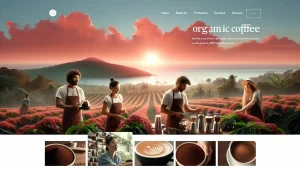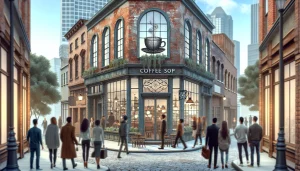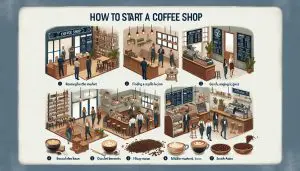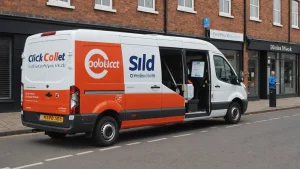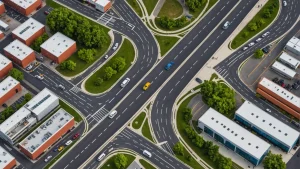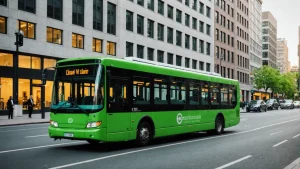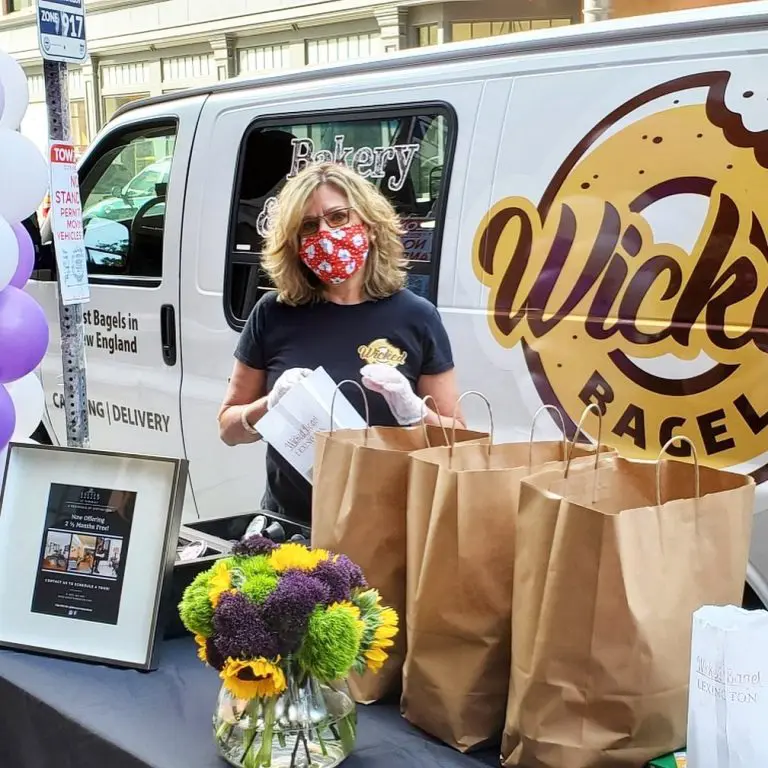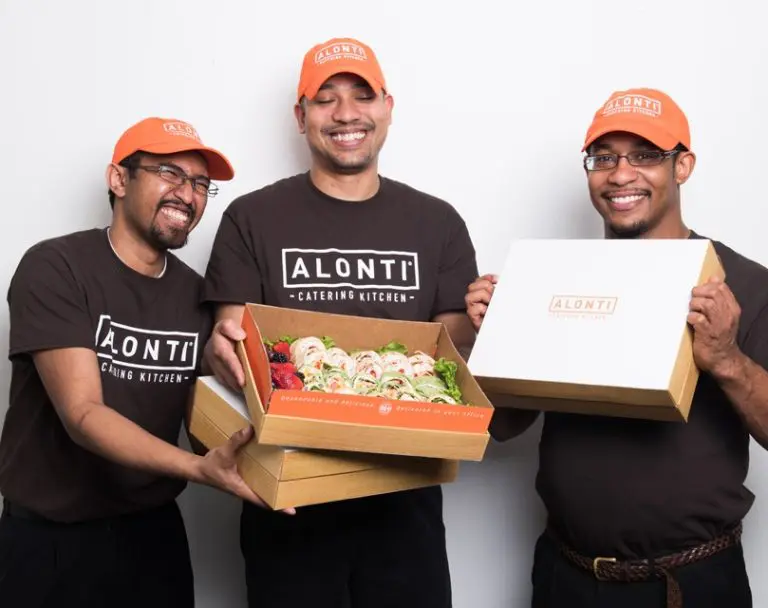Pouring the perfect cup of coffee is an art; choosing the ideal location for coffee shop is pure strategy. It’s similar to playing a rousing game of chess – fewer calculated moves can flip the odds in your favor. Don’t let the thrill of the game distract you from the end goal – you’re on a mission to find that corner of the world where your coffee dreams will thrive in 2024. Discover essential techniques and advice on initiating your coffee shop, including developing a strategic plan, selecting a profitable spot, and building an efficient team.
Each year, more than 100,000 coffee shops sprout worldwide – yet only those who master the location strategy bloom successfully. In the concrete jungle, your café is the patch of warmth sought by every weary urbanite or inspired creative mind. Choosing the right location shifts your café from an overlooked corner to the go-to neighborhood coffee haven. After all, who would bypass the opportunity to fuel their story with a coffee shop that finds familiarity in their fast-paced, anonymous city life? Your small coffee shop might be your anticipated magnum opus, but remember, even the best beans can’t pull customers if they never cross your threshold.
Buckle up, location scouts! It’s time to decode the art and strategy of the right coffee shop location and placement for a prosperous 2024.

Metrobi has been a game changer for coffee industry.
With Metrobi, you can save 23% on delivery costs, save 80% of the time from managing deliveries, and delight your customers with delivery notifications & tracking.
How to Choose the Perfect Coffee Shop Location: A Comprehensive Guide
No two coffee shop locations are the same, picking the next coffee shop and finding the right one can be a game-changer.
Step 1: Understand Your Target Market
The importance of knowing who you’re selling to can’t be stressed enough. If your target market is millennials in urban areas, a downtown district might be ideal. On the other hand, if your target market is retirees, then a place near a park or retirement home could be preferable.
Booming Coffee Consumption ☕️
In the UK, a striking 76% of Baby Boomers report regular coffee consumption, making it their most favored beverage.
Dig deeper into the preferences of your target market. Consider what they value most from a coffee shop—fast service, atmosphere, quality coffee, or possibly, space for holding meetings or working. This understanding will help you to select and open a coffee shop location that caters to these preferred attributes.
Bear in mind the daily patterns and schedules of your customers. If your target market mainly includes office workers looking for a morning caffeine fix, you might want to set up your coffee shop nearby, close to commercial buildings or busy streets with heavy morning traffic. Additionally, considering reliable delivery options is crucial for meeting customer needs and enhancing your service efficiency. Having a solid logistics plan in place with local couriers can help you maintain quick and dependable delivery for your coffee shop products. Learn more about utilizing local services such as couriers in Sacramento to streamline your operations.
Insights into U.S. Coffee Shop Culture 🇺🇸☕
- Millennials represent 44% of coffee consumption in the U.S., signifying a major demographic in the market.
- Daily coffee consumption has reached 48% among 18-24-year-olds and 60% among 25-39-year-olds.
- Approximately 8% of U.S. coffee consumers purchase coffee from a coffee shop daily, while 26.9% do so several times a week.
Step 2: Evaluate the Accessibility and Visibility of Potential Location For Coffee Shop
It’s simple; customers are more likely to visit your coffee shop if they can easily spot and reach it. Like a street actor, if you’re invisible, it’s tough to gather an audience. Discover essential advice and strategies on initiating a coffee shop venture, including securing an accessible and visible location to attract more customers.
Ensure the location is visible from a distance and check the convenience of parking or proximity to public transportation. Moreover, consider integrating services that expand your reach, like reliable delivery. Utilizing efficient Dallas couriers can not only fulfill orders swiftly but also elevate your coffee shop’s presence across the community, tapping into new customer bases.
Being sandwiched between two giant outlets or hidden in a narrow alley might save you rent money but can bleed your business dry in the long run due to a lack of visibility.
On the other hand, a great location at the heart of the city, bustling with people, and high visibility due to significant landmarks will likely have sufficient space to attract a crowd. Remember, out of sight, equals out of mind.
Understanding Small Business Longevity 📉
Roughly 50% of independent businesses cease operations within 5 years, with only around one-third enduring beyond the 10-year mark.
Step 3: Consider the Proximity to Suppliers and Competitors
A key consideration in your location decision should be the proximity to your suppliers. Closer proximity means lesser transportation costs and quicker access, both of which can improve your margins. Thinking of initiating a coffee roasting business? This comprehensive guide includes vital tips like selecting the ideal location for operational efficiency and cost savings.
Yet, the proximity of suppliers should not compromise the profitability that could be eaten up by stiff competition. An area saturated with coffee shops may lead to price wars, which sometimes, is a recipe for bankruptcy.
On the flip side, the absence of competition can work in your favor, but you would need to weigh it against potentially lower demand in the area. So pick a spot keeping these considerations in balance.
That said, while choosing the right coffee supplier and the best location is a crucial first step to a solid business plan, the success of your coffee shop will ultimately lie in your ability to consistently deliver excellent coffee and unmatched customer service.
A stellar location is only the icing on the cake.
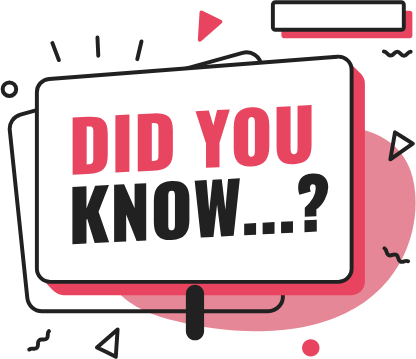
The average Metrobi driver rating is 4.97 / 5.00
Metrobi drivers are highly rated by local businesses for their professionalism and reliability, giving you peace of mind with every delivery.
Factors to Consider When Choosing An Independent Coffee Shop Location
Earning Potential for Coffee Shop Owners 💰☕
Owners of small to medium-sized coffee shops can potentially earn between $60,000 and $175,000 annually, influenced by factors like location, business model, and operational strategy.
The Importance of Foot Traffic
Foot traffic is the lifeblood of any coffee shop concept. High levels of foot traffic increase the chances of attracting both recurring and spontaneous customers, boosting your coffee shop concept’s visibility. It’s where your coffee shop concept’s existence meets potential customers.
Think about locations with high volumes of people: near business districts, shopping malls, transit stations or higher learning institutions, to start with. Research these areas during different hours of the day to truly gauge the foot traffic level.
Nationwide Coffee Shop Popularity 🚶☕
Across most states, roughly 6% to 9% of the population are coffee shop lovers, indicating a substantial number of people nationwide visit coffee shops regularly.
The Role of Local Demographics
Identifying the key demographics of the area is another crucial factor. Pay attention to the population’s age group, occupational background, and income levels. Each impacts the type of coffee and ambiance your coffee shop layout should serve.
For example, a location near a university calls for a coffee shop that caters to studying students, therefore offering free Wi-Fi, extended hours, and affordable options could be beneficial. Comparatively, an upscale neighborhood might prefer artisan coffee, quality beans, a sophisticated ambiance, and luxury offerings to sell coffee to.
The Impact of Rent and Overhead Costs
Start-up costs like rent and overhead are major considerations when picking a location for your coffee shop. Spending too much on these aspects can put undue financial pressure on your entire business.
Take into account the average monthly rent, utility bills, and maintenance costs in your preferred location. A savvy decision would be to balance the foot traffic and demographic advantages with manageable overhead costs.
Coffee Shop Monthly Overheads 💸☕
In general, a coffee shop's monthly expenses typically amount to 75-85% of its monthly sales.
Factors such as lower rent but minimal foot traffic versus high rent with corresponding high foot traffic should be evaluated closely.
Remember, while each of these factors individually contributes to the success of your coffee shop’s location, it’s the combination of foot traffic, favorable local market demographics, and reasonable rent and overhead costs that will truly determine the perfect location for your coffee shop.
Coffee Shop Location Trends in 2024
After mulling over the factors involved in choosing the perfect coffee shop spot, let’s map out the trends that are shaping the coffee shop locations in 2024.
Growth of Coffee Shops in the US 📈☕
In the past half-decade, the United States has seen a 2.4% increase in the quantity of coffee shops.
Urban Vs. Suburban Coffee Shops
Once upon a time, densely populated city centers were the only go-to spots for opening your own coffee beans and shops. However, in 2024, people are gravitating towards less crowded, more tranquil suburban areas, creating opportunities for businesses there. But don’t underestimate the profitability of the urban areas as they offer massive foot traffic and have a diverse customer base.
Where’s the Sweet Spot?
Finding the sweet spot between urban and suburban areas will mean considering various factors. Look into local zoning laws, the density of competition, available infrastructure, commuting patterns, and land values in your chosen areas.
The Emergence of The Third Place
A trend that’s shaping the coffee shop scene is the emergence of coffee shops as the ‘third place’ – a social and physical space separate from the home and the workplace. Customers are now seeking quiet sanctuaries that provide not only quick coffee fixes but also distinct and comfortable experiences.
Coffee Shop Visitation Habits 🚶☕️
- 32% of coffee enthusiasts prefer to visit coffee shops one to three times per week.
- 67% of new parents show a higher tendency to regularly buy coffee from coffee shops.
Creating The Perfect Third Place
To establish your coffee shop as a third place, consider aspects like accessibility, comfort, spacious interiors, WiFi connectivity, and a variety of seating options. Also, the location where you serve coffee plays a huge part. It needs to be in a tranquil yet accessible spot, enticing enough for repeat customers to frequent.
Micro-locations – Coffee Shops-in-Shops
Another new notion in 2024 is micro-locations or ‘Coffee Shops-in-Shops.’ More coffee businesses are branching out to open counter-service coffee shops inside larger establishments like bookstores, office buildings, or mobility hubs.
Choosing a Micro-location
Choosing a micro-location depends largely on the primary audience of the host coffee shop owner. If the host coffee shop owner’s customer demographics align with your target coffee drinkers, you’ve hit the jackpot! It also lends you a valuable opportunity to ride on the credibility and customer loyalty of the established, business owner.
As we move with the currents of 2024, finding the ideal location for your coffee shop isn’t just about ‘where’; it’s also about ‘why’ there. Success in the coffee shop game is all about being in the right place at the right time for the right reasons. Now, let’s shift our focus from the (*hypothetical*) drawing board to the tangible real-world manifestations of these trends. Discover how to craft a website for your coffee shop that attracts more visitors, incorporating elements from online ordering to essential SEO strategies.
Case Studies of Successful Coffee Shop Locations
The Starbucks Story
Starbucks began as a humble little shop in Seattle’s Pike Place Market in 1971. Fast forward to 2024, with more than 30,000 stores globally, the brand has effectively optimized its location strategy. Discover how Starbucks conquered the global coffee scene and learn how you can secure your initial coffee roasting clients by applying their groundbreaking location strategy.
Starbucks' Global Reach 🌍☕
By 2023, Starbucks had solidified its position as one of the premier coffeehouse chains globally, boasting more than 38,000 stores worldwide.
A boat that rowed high in the tide of success, Starbucks showcases the dynamic business structure and the importance of selecting a robust location for coffee shops. They strategically open their outlets in densely populated areas, traffic intersections not all commercial spaces, and tourist locations. The strategy of placing stores in high-visibility and high-traffic commercial areas soon became the Starbucks standard.
While economically feasible stores contribute to coffee shop success, Starbucks’ commitment fosters neighborhood identity, suffusing the local feel, which echoes in its interiors, and is pivotal in its astounding fame.
How Costa Coffee Captured the UK Market
Costa Coffee, a prominent UK coffee chain, traditionally focused on high street locations within small towns. It has since broadened its reach, and as of 2024, Costa Coffee claims various locations – shopping districts, to-go kiosks in busy urban centers, drive-throughs, and partnership locations in bookstores, cinemas, and airports.
Costa Coffee's Growth in the UK 🇬🇧☕
In the last decade, Costa Coffee's units in the UK have reached 2,300.
Costa’s secret sauce lies in saturating a specific region with stores to capture customer loyalty and outwit competition. Their strategy of building community and customer loyalty has empowered them to thrive even in historically challenging locations for food and beverage businesses.
While it’s been successful, this saturation strategy isn’t universally applicable, and Costa’s outreach further mirrors this. Their localized menus and store layouts in international outlets, implying the importance of fitting into the local culture while retaining the brand, are noteworthy.
Blue Bottle’s Pioneering Craft Coffee Movement
Blue Bottle Coffee, since its inception in 2002, has made significant strides, fostering a community that loves and appreciates brews crafted with care and quality. At the heart of their strategic location and strategy lies their dedication to being an urban coffee shop, targeting areas with foot traffic and a considerable number of young professionals.
Their store locations span active business districts, crowded hubs, tech campuses, and high-end shopping malls, to name a few. They also bet big on dense urban markets with high median income levels.
Blue Bottle uniquely emphasizes the interior design of its stores, manifesting an artistic and minimalistic style, that reflects their coffee’s artisanal trait. They embody the concept of “less is more” and keep the emphasis on coffee quality and customer service in every store.
The success stories of giants, like Starbucks, Costa, and Blue Bottle, offer valuable insights into the significant role selecting the right locations plays in scaling a coffee shop business concept. Their strategies to foster a local community, fitting into the local culture yet retaining the brand ethos, and strategically targeting locations, narrate volumes about the crucial elements that foster a successful, coffee shop business plan. Regardless of your coffee shop size, these successful cases present essential lessons that can be customized as per your requirements, enhancing your chances of success in your own coffee, shop venture.
Evaluating Potential Coffee Shop Locations: A Checklist
Identify Competitors and Business Environment
Analyzing the competition is crucial in the coffee shop industry. You need to know the players in your market and their locations. Equally important is the overall condition of the local coffee industry, coffee shop equipment, and market. Too many coffee shops in one area can reduce your potential business – a phenomenon known as market saturation.
Find out how many other coffee shops there are operating within a reasonable distance of your potential location. Note their operating hours, coffee prices used, and, most importantly, the volume and flow of their customers. All these factors will help paint a clearer picture of the potential success of your coffee business in this area.
Also, consider the overall business environment. Areas with a high density of offices are prime locations as they often have a constant stream of workers and clients craving their caffeine fix.
Cutthroat competition can be good if you’re better. But if you’re first starting out? You might want to find an underserved area.
Choosing the Right Demographics
Choosing the right customer demographics is vital for your coffee shop’s success. Understanding your target demographic can guide the positioning of your existing coffee shop or business. An essential element in your business strategy is understanding the logistics of delivery services. For instance, hiring a reliable courier service in Austin can enhance your operations, ensuring timely deliveries that meet customer expectations and give you a competitive edge.
If you’re targeting young professionals, setting up your coffee shop near office buildings or business parks might be a smart move. On the other hand, if your target customers are college students, selecting a location in bustling student areas close to universities could prove beneficial.
Demographic information can go beyond age and occupation. It can also include lifestyle information like the average income, which can inform your pricing strategy, or popular local activities, which can guide your marketing decisions.
Zoning Laws and Traffic Pattern Considerations
Zoning laws and traffic patterns are other important location-related issues that coffee shop owners need to consider. Local zoning laws dictate what types of businesses can operate in a certain location.
For instance, opening a coffee shop might be completely prohibited in industrial zones, but is likely allowed in most commercial spaces and retail zones. Even within retail zones, there can be limitations about the types of retail businesses that can operate. Therefore, it is essential to fully understand the zoning laws of your potential location before making any purchase or rental decisions about actual space.
In terms of traffic patterns, it is always better to choose areas with high foot traffic. Lots of people walking past your new coffee shop can result in more customers and higher sales.
However, you may also need to consider car traffic since many people prefer to drink their coffee on their commute to work. Some coffee shops even provide drive-thru service to accommodate their car-driving customers.
A Savvy Step to Brewing Success
As you’ve discovered, opening the perfect coffee shop isn’t just about a stellar brew—it’s a challenge of finding the right location, thorough market analysis, embracing the local vibe, and forecasting future trends.
Imagine this: Your bustling café, uniquely embodied by the local culture, yet consistently forward-thinking. It’s adaptable, thriving, and a haven for the caffeine-starved crowd. Now picture this in your desired location.
The power is in your hands. Start scouting potential spots, engage in conversations with locals, do field research, determine your competition, and map out future inclinations of the area.
Are you ready for the leap? Can you, as a new brewmaster and prospective café owner, embrace this exciting and transformative venture to its fullest potential?
Remember, your open coffee shop’s success may be brewing in the details of its location. All set to start brewing?”





